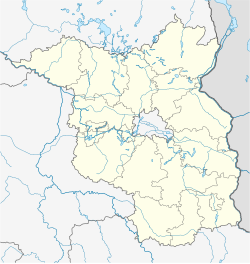world.wikisort.org - Germany
Kotzen is a municipality in the Havelland district, in Brandenburg, Germany.
Kotzen | |
|---|---|
Municipality | |
Location of Kotzen within Havelland district  | |
 Kotzen  Kotzen | |
| Coordinates: 52°37′59″N 12°31′00″E | |
| Country | Germany |
| State | Brandenburg |
| District | Havelland |
| Municipal assoc. | Nennhausen |
| Subdivisions | 4 Ortsteile |
| Government | |
| • Mayor (2019–24) | Franziska Blask[1] |
| Area | |
| • Total | 42.73 km2 (16.50 sq mi) |
| Elevation | 27 m (89 ft) |
| Population (2020-12-31)[2] | |
| • Total | 616 |
| • Density | 14/km2 (37/sq mi) |
| Time zone | UTC+01:00 (CET) |
| • Summer (DST) | UTC+02:00 (CEST) |
| Postal codes | 14715 |
| Dialling codes | 033874 |
| Vehicle registration | HVL |
| Website | www.amt-nennhausen.de |
Demography

|
|
Translation
Since one English translation of the German verb "kotzen" is "to vomit", the town was jokingly[original research?] incorrectly referred to in Ripley's Believe-It-or-Not under the title "Barfburg". More prosaically the name probably comes from the Slavonic-German noun "Kotzen" which means market place, as per the Theater an der Kotzen, Divadlo v Kotcích in Prague.
Personalities
Explorer Karl Klaus von der Decken was born in Kotzen in 1833.
References
- Landkreis Havelland Wahl der Bürgermeisterin / des Bürgermeisters, accessed 1 July 2021.
- "Bevölkerung im Land Brandenburg nach amtsfreien Gemeinden, Ämtern und Gemeinden 31. Dezember 2020". Amt für Statistik Berlin-Brandenburg (in German). June 2021.
- Detailed data sources are to be found in the Wikimedia Commons.Population Projection Brandenburg at Wikimedia Commons
External links
![]() The dictionary definition of kotzen at Wiktionary
The dictionary definition of kotzen at Wiktionary
На других языках
- [en] Kotzen
[ru] Коцен (Бранденбург)
Коцен (нем. Kotzen) — коммуна в Германии, в земле Бранденбург.Текст в блоке "Читать" взят с сайта "Википедия" и доступен по лицензии Creative Commons Attribution-ShareAlike; в отдельных случаях могут действовать дополнительные условия.
Другой контент может иметь иную лицензию. Перед использованием материалов сайта WikiSort.org внимательно изучите правила лицензирования конкретных элементов наполнения сайта.
Другой контент может иметь иную лицензию. Перед использованием материалов сайта WikiSort.org внимательно изучите правила лицензирования конкретных элементов наполнения сайта.
2019-2025
WikiSort.org - проект по пересортировке и дополнению контента Википедии
WikiSort.org - проект по пересортировке и дополнению контента Википедии
